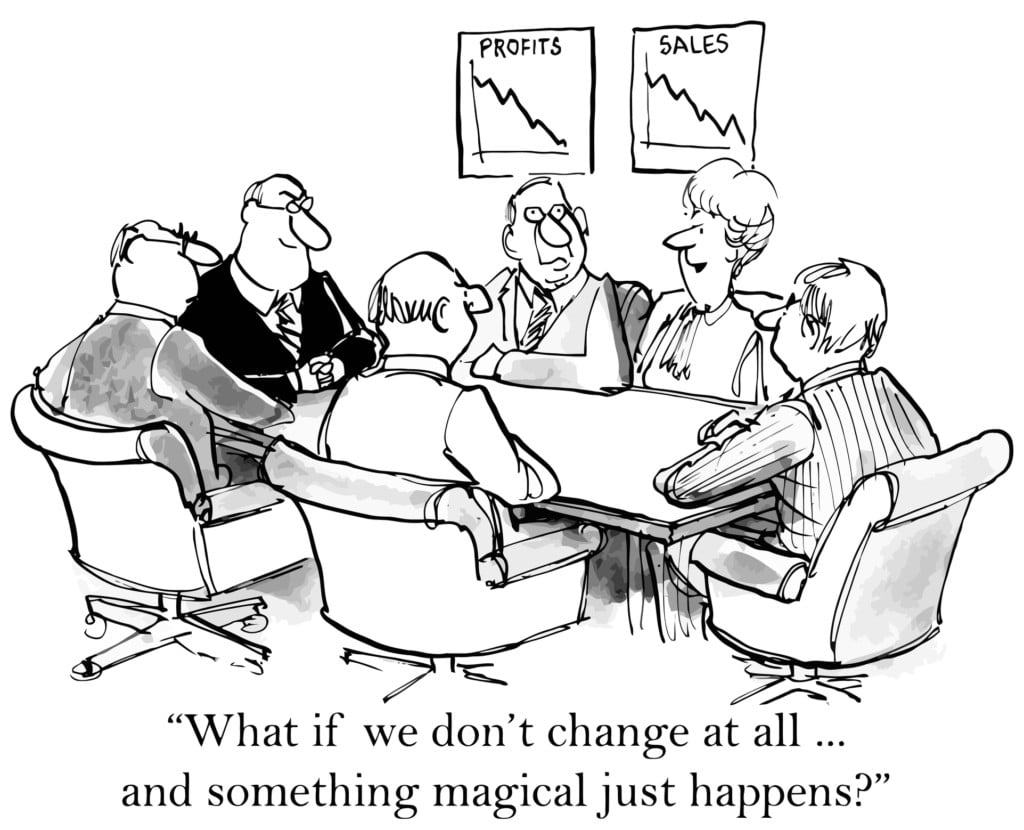Transformation is a term that we hear a lot in business, but what does it mean and how do we do it? Below we’ve given some answers to the more common questions we get asked.
Firstly, not all change is transformational. Unlike developmental change or transitional change, which aim to improve existing processes and structures, transformational change refers to large scale dismantling of a company’s underlying structure, culture or operations. The aim is to create something totally new that will become a significant part of the company’s future success. The general consensus is that at least 40% of the business is new or almost unrecognisable from the past. The difference in the organisation will be obvious to pretty much everyone who works in the business or who interacts with it. And yes the term transformation is often overused.
The process itself is nonlinear and full of twists, turns and surprises. Both radical and disruptive, transformational change is extremely challenging. However, metamorphosis is sometimes required to secure the future of a business. When it comes to completely overhauling an organisation, the words of the Ancient Greek philosopher Socrates spring to mind: “The secret of change is to focus all of your energy not on fighting the old but building the new”.
With that in mind, we consider below some of the questions we get asked about how to make a success of transformational change.
Why is transformational change needed?
Transformational change is episodic. It often occurs in response to, or anticipation of, extreme or unexpected market changes. It can also occur in response to a crisis. Other less ominous reasons can prompt transformational change, for example, the adoption of emerging technology can force it to happen. Similarly, organisational change may be necessary to take advantage of new business models. On a human level, transformation can occur as the result of key leadership changes within an organisation. A new spearhead may catalyse immense modifications from the top down to bring a fresh company vision to life. While it may seem scary, successful transformation can often be critical to the long term survival of companies – or even entire industries.
What does transformational change involve?
Transformational change is nothing less than a paradigm shift. It involves a significant, if not total, revision of a firm’s business strategy. Usually, this means modifying internal structures and processes to support a brave new direction. This might mean centralising operations, adopting new technology or creating a global business hub. Inevitably, changes at this scale will have an impact on corporate culture, and this shift will alter the very fabric of the organisation. With transformational change, the future state of the company is often unknown at the beginning. A new landscape is carved out through a process of trust, trial and error, as new information is acquired. There may be an overarching strategy in place, but the process of the change often emerges organically. This means everyone from executives to managers and senior leaders must operate in an unknown world for a period of time. This can feel daunting, but it is the only way to get to a point where the organisation emerges completely new, or unrecognisable compared to the past.
How do you lead transformational change?
Leaders looking to implement transformational change should never underestimate the power of demonstrating passion for their vision. But being realistic is important too. For transformational change to be successful, company frontrunners need to understand the amount of work required to make it happen. A great leader should continually make calls of judgement about their company’s capacity to make necessary changes and evaluate how connected their workforce is to the transformation. Some decision-making may need to be centralised at the top but excluding lower-level employees from communication and even a degree of decision making around the transformation process can be extremely detrimental as it affects everyone directly. We all need to feel masters of our own destiny so try to ensure this is considered where possible. Some keys to engaging people in transformational change include creating a sense of urgency to get everyone on board with the initial idea, removing resistance by offering reassurance regularly and being transparent about successes and setbacks along the way. The overall aim is to inspire a strong sense of trust in the change programme and in those leading it
If in doubt there are plenty of useful change management models to use for reference, although keep in mind that like all good tools it’s how you use them that makes the difference. This is certainly true with transformational change.
Why is transformational change difficult?
On an individual level, humans are hardwired to resist change. We have problems coping with radical, disruptive change because part of the brain (the amygdala) interprets it as a threat and prompts us to fight, or flight. In business, transformation may generate worries about job security. The bigger the change, the more uncertainty, and the more fearful we are. As a leader, the implementation of successful transformational change means being devoted to the integration and application of your new strategy and processes. Making the right strategic choices – at the correct time – is key to ensuring disruption brings about positive new behaviours and values. Try to engage all your staff members and actively listen to what they have to say, making every effort to address their concerns. Once you have fostered a new mentality, you are halfway there, because attitudes will form the groundwork of ongoing organisational success. Orchestrating such behavioural changes is a skill to master. Once your workforce is in alignment with your capabilities and environment, you are close to success.
What are the four stages of transformational change?
Bodies of scholarly research support the idea that there are four stages to anticipate during periods of major change and transition. These stages apply to big changes within one’s personal life, but they can also be helpful in understanding the acceptance of transformational change within a business setting. The first stage is denial (when individuals withdraw and focus on the past). The second is resistance (the most difficult stage when feelings of anger and anxiety are expressed). The third is exploration (when employees begin accepting the process and optimism and morale gradually increases). The fourth stage is commitment (when you’ll finally see cooperation, improved focus and an increased level of trust). Being prepared for each stage, removing roadblocks and responding to each phase early rather than late can ensure your transformational change presses ahead as smoothly as possible.
How do you deal with a resistant team?
When thinking about the four changes of transformational change, as a leader, you need to be aware that everyone adjusts to change at different rates. Each adjustment phase requires a great deal of time and effort from each individual. Your teams may need to re-learn their current position, and the upheaval may catalyse psychological resistance. A change in performance is often an early warning sign of resistance. You, or your leadership team, may notice certain individuals rapidly halt productivity. They may make more mistakes than usual and generally pay less care and attention to everyday tasks. Trying to understand the basics of behavioural science can be helpful in supporting your people through your business transformation. Factors such as personality, demographics and hierarchical position can all influence the tendency towards resistance. By pre-emptively identifying the most change-resistant individuals before getting the ball rolling, you can ensure adequate support is in place to help them adjust more smoothly and prevent any performance issues. Read more about dealing with resistant teams.
How do you implement transformational change?
Winston Churchill once said, “It is no use saying, ‘we are doing our best’. You have got to succeed in doing what is necessary.” Often, with transformational change, time is of the essence. If a crisis or unexpected market changes prompt a big shift, the speed of new developments can be crucial. Pay attention to items that need priority attention and tackle them at scale, with speed. If your environment has shifted astronomically or technology has advanced vastly, you must react with agility. Strong leadership and swift decision making will ensure that traditional behaviours and capabilities are left firmly in the past, paving the way for a fresh new tomorrow. Incentives can also help encourage commitment. Performance reviews, financial arrangements, incentive schemes and bonuses can be advantageous in nudging valued employees in the right direction.
What makes transformational change successful?
Implementing radical new structures and processes is no mean feat. Creating a new culture is unbelievably tricky. But it can be done. For transformational change to be successful, both leaders and workers must be prepared to embrace a radical shift in perspective. Getting everyone across the board involved is fundamental to securing a new future – only then can your business operate effectively. Transformational change demands that all individuals put personal agendas aside for a period, for the overall good of the enterprise. To encourage people to embrace your vision and new ways of working, learn from transformational change stories. Draw on lessons from other organisations that have achieved success (and those that have emerged utter failures).
Generally, the most common message is that organisational change is a wild journey that takes a considerable length of time. Usually, the most successful stories highlight that true transformational change is nonlinear. Instead, it is a process made up of a series of phases, and along the way, some setbacks are to be expected. The aim is to remove roadblocks as quickly as possible, while systematically planning for and creating short term wins. Ensure no step is missed – fast-tracking might give the illusion of speed, but it will likely not yield a satisfying result. Strong leadership is essential every step of the way – and the best leaders never announce victory too soon.
Understanding just how ready you are for change is critical, ideally before you start and as you take the journey too. How those involved feel about and perceive the change will play a huge part in how well it goes. Good quality conversation is a great place to start and ideally alongside a well-designed change readiness assessment so you can see how well those conversations are landing
Something to reflect on
For transformational change to be truly successful it requires each and every one of the people involved to take their own journey of transformation, to let go, to conceptualise a new future for themselves and for the business. Change leadership is about creating the conditions where they can do that, guiding, encouraging and reassuring them as they make that journey.
There you have it – everything you need to know about how to make transformational change. If you’d like to know more or need help with your transformation get in touch with us today. We’ve learnt a lot and and continue to do so because change involves people and so the topic is both fascinating and endlessly surprising. That change happens is not something we can necessarily control, but we can at least be ready for it.








